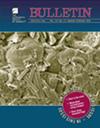怀俄明西北部新太古代-古元古代地壳生长演化:蒙大拿变质沉积岩锆石U-Pb年龄和Lu-Hf同位素证据
IF 3.9
1区 地球科学
Q1 GEOSCIENCES, MULTIDISCIPLINARY
引用次数: 0
摘要
位于怀俄明州北部的蒙大拿变质沉积岩为研究克拉通边缘的地壳形成和改造过程提供了宝贵的见解,并为破译Laurentia西南部复杂的新太古代-古元古代地层组合提供了独特的机会。本文报道了美国蒙大拿州西北部7个变质岩样品的锆石U-Pb测年和Hf同位素。本研究的锆石内部结构复杂;有些缺乏遗传岩心和变质过度生长,而另一些则表现出岩心-边缘关系。根据阴极发光(CL)特征,我们认为这些颗粒为岩浆群。这些数据显示了2.7 Ga、2.4 Ga和1.7 Ga的离散火成岩脉冲,这表明蒙大拿变质沉积地体中存在明显的地壳形成间隔。2.7 Ga锆石εHf值为正(+2.4 ~ +0.9),表明地幔源为衰竭。大部分2.4 Ga和1.7 Ga样品的εHf值为负(- 1.6 ~ - 15.5),表明前人地壳对样品的贡献较大。然而,两个1.7 Ga样品的εHf值(+0.4至+0.3)接近球粒体,表明幼体的贡献较大。时间积分的Hf同位素趋势表明,古元古代锆石是由较老的地壳和较年轻的地幔混合输入产生的。此外,蒙大拿元沉积地体的同位素年龄指纹表明其与北界地体不同。从更广泛的角度来看,蒙大拿变质沉积岩的2.7 Ga和1.7 Ga年龄峰值与全球锆石年龄谱共享,表明蒙大拿变质沉积岩这些事件的驱动因素在整个地球上是共同的,可能与Kenorland和Nuna超大陆的组合有关。本文章由计算机程序翻译,如有差异,请以英文原文为准。
Growth and evolution of Neoarchean−Paleoproterozoic crust in the NW Wyoming Province: Evidence from zircon U-Pb age and Lu-Hf isotopes of the Montana metasedimentary terrane
The Montana metasedimentary terrane in the northern Wyoming Province provides valuable insight into crustal formation and reworking processes along the cratonic margin and offers a unique opportunity to decipher the complex Neoarchean−Paleoproterozoic terrane assembly in southwestern Laurentia. We report new zircon U-Pb dates and Hf isotopes from seven metaigneous samples in the northwestern Montana metasedimentary terrane. The internal textures of zircon in this study are complex; some lack inherited cores and metamorphic overgrowths, while others exhibit core-rim relationships. Based on the cathodoluminescence (CL) features, we interpret these grains to be magmatic populations. These data demonstrate discrete igneous pulses at 2.7 Ga, 2.4 Ga, and 1.7 Ga, which indicate significant crustal formation intervals in the Montana metasedimentary terrane. Zircons at 2.7 Ga have positive εHf values (+2.4 to +0.9) that indicate a depleted mantle source. Most 2.4 Ga and 1.7 Ga samples have negative εHf values (−1.6 to −15.5), which indicate significant contributions from preexisting crust. Two 1.7 Ga samples, however, have near-chondritic εHf values (+0.4 to +0.3) that indicate larger juvenile contributions. The time-integrated Hf isotope trend suggests that the Paleoproterozoic zircons were produced from a mixture of older crust and juvenile mantle inputs. Additionally, the isotopic age fingerprint of the Montana metasedimentary terrane suggests that it differs from northern-bounding terranes. Viewed more broadly, the 2.7 Ga and 1.7 Ga age peaks that the Montana metasedimentary terrane shares with the global zircon age spectrum suggest that the drivers of these events in the Montana metasedimentary terrane were common throughout the Earth and may be associated with the assembly of supercontinents Kenorland and Nuna.
求助全文
通过发布文献求助,成功后即可免费获取论文全文。
去求助
来源期刊

Geological Society of America Bulletin
地学-地球科学综合
CiteScore
9.30
自引率
8.20%
发文量
159
审稿时长
4-8 weeks
期刊介绍:
The GSA Bulletin is the Society''s premier scholarly journal, published continuously since 1890. Its first editor was William John (WJ) McGee, who was responsible for establishing much of its original style and format. Fully refereed, each bimonthly issue includes 16-20 papers focusing on the most definitive, timely, and classic-style research in all earth-science disciplines. The Bulletin welcomes most contributions that are data-rich, mature studies of broad interest (i.e., of interest to more than one sub-discipline of earth science) and of lasting, archival quality. These include (but are not limited to) studies related to tectonics, structural geology, geochemistry, geophysics, hydrogeology, marine geology, paleoclimatology, planetary geology, quaternary geology/geomorphology, sedimentary geology, stratigraphy, and volcanology. The journal is committed to further developing both the scope of its content and its international profile so that it publishes the most current earth science research that will be of wide interest to geoscientists.
 求助内容:
求助内容: 应助结果提醒方式:
应助结果提醒方式:


